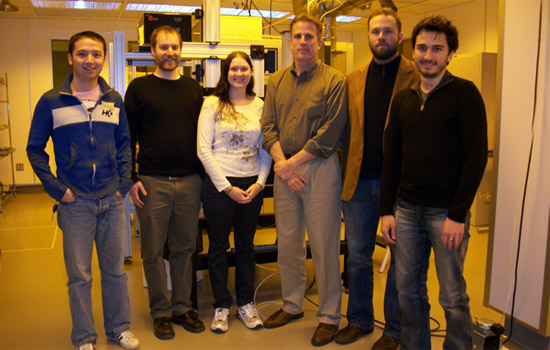Engineering doctoral student wins Best in Session
Burak Baylav’s solutions for line edge roughness featured at TECHCON 2013
Provided
Burak Baylav (far right) was the recent Best in Session winner at TECHCON 2013 for his research on a new processing technique with viable implications for the semiconductor industry. He is shown with student-colleagues from the Nanolithography Research Lab in the Kate Gleason College of Engineering (left to right) Peng Xie, Neal Lafferty, Monica Kempsell, Professor Bruce Smith and Andrew Estroff.
Burak Baylav, a microsystems doctoral student at Rochester Institute of Technology, won a “Best in Session” designation at TECHCON 2013. He presented research on a new processing technique with viable implications for the semiconductor industry at the event sponsored by the Semiconductor Research Corp. on Sept. 9-10 in Austin, Texas. The conference showcases progressive research in new materials and processes created to advance future generations of integrated circuit and computer chip technologies by university-corporate collaborations.
Baylav’s recognition was for the “Impact of Pupil Plane Filtering on Mask Roughness Transfer.” His work was part of a project sponsored by international semiconductor firm GLOBALFOUNDRIES and the Semiconductor Research Corp.
In his research, he detailed the reliability of dense, integrated circuit patterns, specifically roughness present along pattern edges. Known as “line edge roughness,” it affects electrical characteristics of devices, causing variations in threshold voltage and current leakage. Line edge roughness has several contributing factors, including those coming from the masking pattern used in the manufacturing process. Baylav proposed an optical filtering technique to eliminate the transfer of masking pattern roughness.
Baylav is part of the Nanolithography Research Lab group, under the advisement of Professor Bruce Smith, in RIT’s Kate Gleason College of Engineering. He is a member of SPIE, the Optical Society of America and IEEE. He received his master’s degree in microelectronic engineering from RIT in 2010 and an undergraduate degree in electrical engineering from Yeditepe University in Istanbul, Turkey, in 2006. He will defend his dissertation later this year and begin work at Intel Corp. in February 2014.







